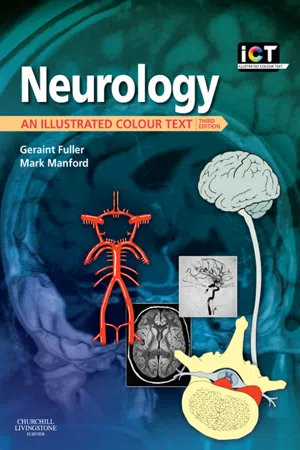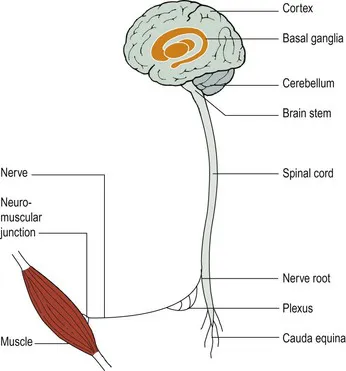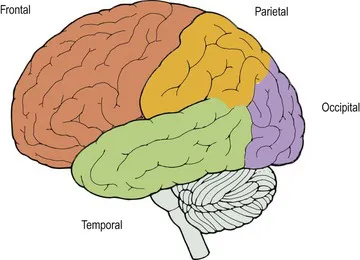
- 144 pages
- English
- ePUB (mobile friendly)
- Available on iOS & Android
About this book
An introductory textbook of neurology in the Illustrated Colour Text series, making full use of all the usual features of the series - double page spreads, short paragraphs, summary boxes, attractive use of colour etc.- Clear explanation of neurological examination - often found very taxing by students.- Demonstrates how to approach common neurological presentations, such as blackouts and numbness, before moving on to a comprehensive coverage of syndromes and diseases.- Concentrates on the core curriculum which the medical student really needs to know.- Updated management in the light of new evidence and new drugs most notably in Parkinson's disease, epilepsy and multiple sclerosis.- Images, particularly MRI scans, updated with more modern and higher resolution images.- Includes a new double-page spread on Sleep.- Extra material added on giddiness to include the head thrust test and Epley's manoeuvre.
Frequently asked questions
- Essential is ideal for learners and professionals who enjoy exploring a wide range of subjects. Access the Essential Library with 800,000+ trusted titles and best-sellers across business, personal growth, and the humanities. Includes unlimited reading time and Standard Read Aloud voice.
- Complete: Perfect for advanced learners and researchers needing full, unrestricted access. Unlock 1.4M+ books across hundreds of subjects, including academic and specialized titles. The Complete Plan also includes advanced features like Premium Read Aloud and Research Assistant.
Please note we cannot support devices running on iOS 13 and Android 7 or earlier. Learn more about using the app.
Information
The levels of the nervous system











The central nervous system
The cerebral hemispheres





The basal ganglia
Table of contents
- Cover
- Title Page
- Front Matter
- Copyright
- Preface
- Acknowledgements
- Table of Contents
- Chapter 1: Organization of the nervous system
- Chapter 2: Neurological thinking
- Chapter 3: Pathological processes in neurology
- Chapter 4: History taking
- Chapter 5: Examination: introduction
- Chapter 6: Speech and higher function
- Chapter 7: The eyes and visual system
- Chapter 8: Fundoscopy
- Chapter 9: Cranial nerves 1, 3–6
- Chapter 10: Other cranial nerves
- Chapter 11: Limbs: motor
- Chapter 12: Limbs: reflexes and sensation
- Chapter 13: Gait, coordination and abnormal movements
- Chapter 14: Neuroradiology
- Chapter 15: Neurophysiological investigations
- Chapter 16: Nerve conduction studies and electromyography
- Chapter 17: Neurogenetics
- Chapter 18: Cerebrospinal fluid and lumbar puncture
- Chapter 19: Headache
- Chapter 20: Blackouts and ‘funny do’s’
- Chapter 21: Giddiness
- Chapter 22: Intracranial pressure
- Chapter 23: Coma and alteration of consciousness
- Chapter 24: Confusion and delirium
- Chapter 25: Dementia
- Chapter 26: Disturbances of vision
- Chapter 27: Weakness
- Chapter 28: Numbness and sensory disturbance
- Chapter 29: Walking difficulties and clumsiness
- Chapter 30: Stroke I
- Chapter 31: Stroke II
- Chapter 32: Stroke III
- Chapter 33: Transient ischaemic attacks and prevention of strokes
- Chapter 34: Subarachnoid haemorrhage
- Chapter 35: Epilepsy I: Diagnosis
- Chapter 36: Epilepsy II: Treatment and management
- Chapter 37: Head injury
- Chapter 38: Spinal cord syndromes
- Chapter 39: Radiculopathy
- Chapter 40: Multiple sclerosis I
- Chapter 41: Multiple sclerosis II
- Chapter 42: Parkinson’s disease and other akinetic rigid syndromes I
- Chapter 43: Parkinson’s disease and other akinetic rigid syndromes II
- Chapter 44: Other movement disorders
- Chapter 45: CNS neoplasia I: Intracranial tumours
- Chapter 46: CNS neoplasia II: Special situations
- Chapter 47: Infections of the nervous system I
- Chapter 48: Infections of the nervous system II
- Chapter 49: Peripheral neuropathies I: Clinical approach and investigations
- Chapter 50: Peripheral neuropathies II: Clinical syndromes
- Chapter 51: Common peripheral nerve lesions
- Chapter 52: Disorders of the motor neurone
- Chapter 53: Disorders of the neuromuscular junction
- Chapter 54: Muscle disease
- Chapter 55: The autonomic nervous system
- Chapter 56: Functional disorders
- Chapter 57: Sleep and sleep disorders
- Chapter 58: Neurology and psychiatry
- Chapter 59: Rehabilitation
- Chapter 60: Case histories
- Chapter 61: Case histories: Answers
- Appendix I
- Appendix II
- Appendix III
- Index